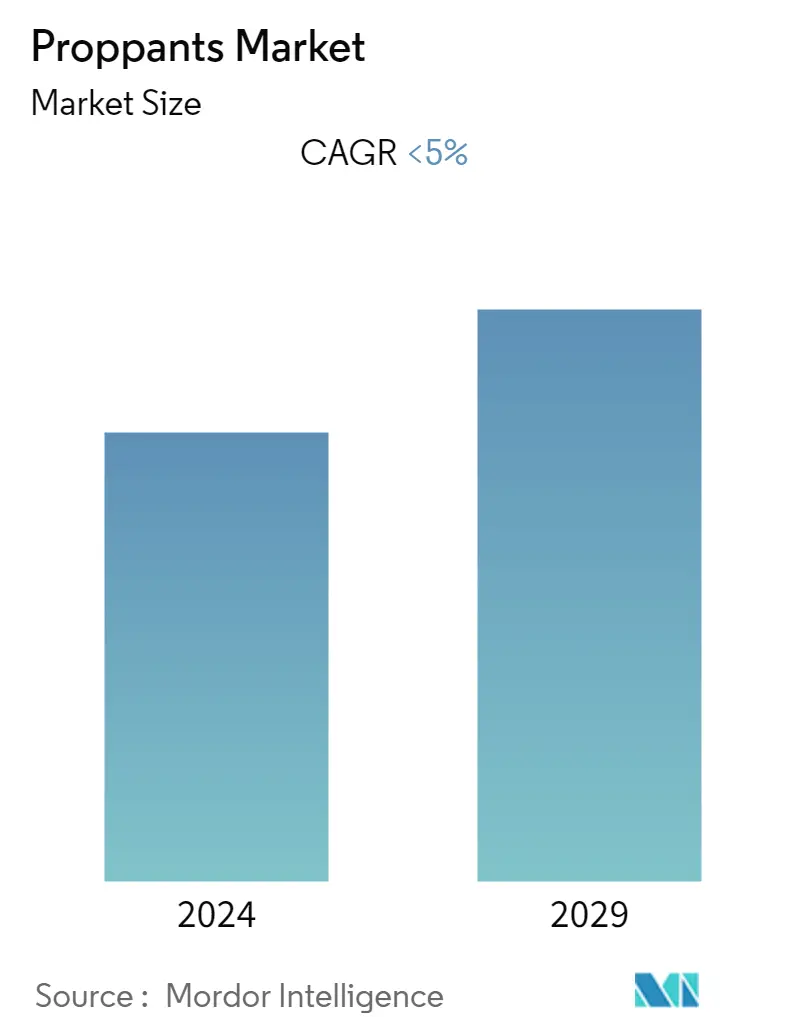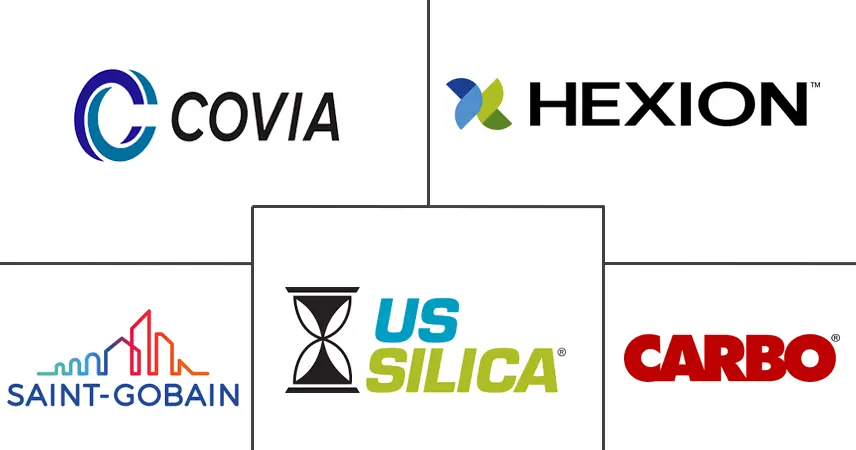Market Size of Proppants Industry

| Study Period | 2019 - 2029 |
| Base Year For Estimation | 2023 |
| CAGR | 5.00 % |
| Fastest Growing Market | North America |
| Largest Market | North America |
| Market Concentration | Low |
Major Players
*Disclaimer: Major Players sorted in no particular order |
Proppants Market Analysis
The proppants market is estimated at 157 million tons currently and is expected to reach 204 million tons over the forecast period, registering a CAGR of around 5% during the forecast period.
The major application of proppants is in oil and gas wells. Due to COVID-19 and geopolitics, the demand for crude oil decreased as markets had been over-supplied, thus forcing OPEC+ producers to cut the output. It is expected to affect the demand for various proppants such as frac sand, resin coated, and ceramics.
- In the medium term, improvements in fracking technology and increasing shale gas production activities are expected to drive the market studied. The Energy Information Administration (EIA) expects shale natural gas and oil production to double by 2040. According to EIA, shale gas and tight oil production will increase from about 14 trillion cubic feet (Tcf) in 2015 to 29 Tcf in 2040, enhancing market demand.
- However, environmental concerns and stringent regulations will likely hinder the studied market's growth.
- North America dominated the market across the world, with the largest consumption from the United States.
- Shifting focus toward using ceramic proppants is expected to provide opportunities for the market studied.
Proppants Industry Segmentation
A proppant is a solid material, usually sand, treated sand, or artificial ceramic materials, used to maintain the openness of an induced hydraulic fracture during or after fracturing. The market is segmented by product type and geography. The market is segmented by product type into frac sand, resin coated, and ceramics. The report also covers the market size and forecasts for the proppants market in 17 countries across major regions. Each segment's market sizing and forecasts are based on volume (million tons).
| Product Type | |
| Frac Sand | |
| Resin Coated | |
| Ceramics |
| Geography | |||||||||
| |||||||||
| |||||||||
| |||||||||
| |||||||||
|
Proppants Market Size Summary
The proppants market is experiencing a steady growth trajectory, driven primarily by its application in oil and gas wells. Despite challenges posed by the COVID-19 pandemic and geopolitical tensions leading to reduced crude oil demand, the market is poised for expansion. The advancement of fracking technology and the increase in shale gas production activities are significant factors contributing to this growth. North America, particularly the United States, dominates the global market, with a substantial portion of proppants consumption attributed to hydraulic fracturing activities. The shift towards ceramic proppants is anticipated to create new opportunities within the market. However, environmental concerns and stringent regulations remain potential obstacles to market growth.
Frac sand proppants, known for their high purity and durability, constitute the majority of proppants used in hydraulic fracturing due to their cost-effectiveness and availability. The United States leads in the exploration of unconventional crude oil reserves, with a significant increase in oil production from hydraulically fractured wells. This trend is mirrored in other regions, such as Canada and China, where shale gas production is expected to rise significantly. Despite the challenges posed by environmental and health concerns related to hydraulic fracturing, the demand for proppants is expected to grow, supported by ongoing investments in oil and gas infrastructure. The market remains fragmented, with key players like Saint-Gobain, Hexion, and CARBO Ceramics Inc. actively shaping the competitive landscape.
Proppants Market Size - Table of Contents
-
1. MARKET DYNAMICS
-
1.1 Drivers
-
1.1.1 Improvements in Fracking Technology
-
1.1.2 Increasing Shale Gas Production Activities
-
-
1.2 Restraints
-
1.2.1 Environmental Concerns and Legislation
-
1.2.2 Impact of COVID-19 Outbreak
-
-
1.3 Industry Value Chain Analysis
-
1.4 Porter's Five Forces Analysis
-
1.4.1 Bargaining Power of Suppliers
-
1.4.2 Bargaining Power of Buyers
-
1.4.3 Threat of New Entrants
-
1.4.4 Threat of Substitute Products and Services
-
1.4.5 Degree of Competition
-
-
-
2. MARKET SEGMENTATION (Market Size in Volume)
-
2.1 Product Type
-
2.1.1 Frac Sand
-
2.1.2 Resin Coated
-
2.1.3 Ceramics
-
-
2.2 Geography
-
2.2.1 Asia-Pacific
-
2.2.1.1 China
-
2.2.1.2 India
-
2.2.1.3 Indonesia
-
2.2.1.4 Malaysia
-
2.2.1.5 Thailand
-
2.2.1.6 Vietnam
-
2.2.1.7 Rest of Asia-Pacific
-
-
2.2.2 North America
-
2.2.2.1 United States
-
2.2.2.2 Canada
-
2.2.2.3 Mexico
-
-
2.2.3 Europe
-
2.2.3.1 Germany
-
2.2.3.2 United Kingdom
-
2.2.3.3 Russia
-
2.2.3.4 Norway
-
2.2.3.5 Rest of Europe
-
-
2.2.4 South America
-
2.2.4.1 Brazil
-
2.2.4.2 Argentina
-
2.2.4.3 Rest of South America
-
-
2.2.5 Middle-East and Africa
-
2.2.5.1 Saudi Arabia
-
2.2.5.2 South Africa
-
2.2.5.3 Rest of Middle-East and Africa
-
-
-
Proppants Market Size FAQs
What is the current Proppants Market size?
The Proppants Market is projected to register a CAGR of less than 5% during the forecast period (2024-2029)
Who are the key players in Proppants Market?
Hexion, U.S. Silica, CARBO Ceramics Inc., Covia Holdings LLC and Saint-Gobain are the major companies operating in the Proppants Market.

